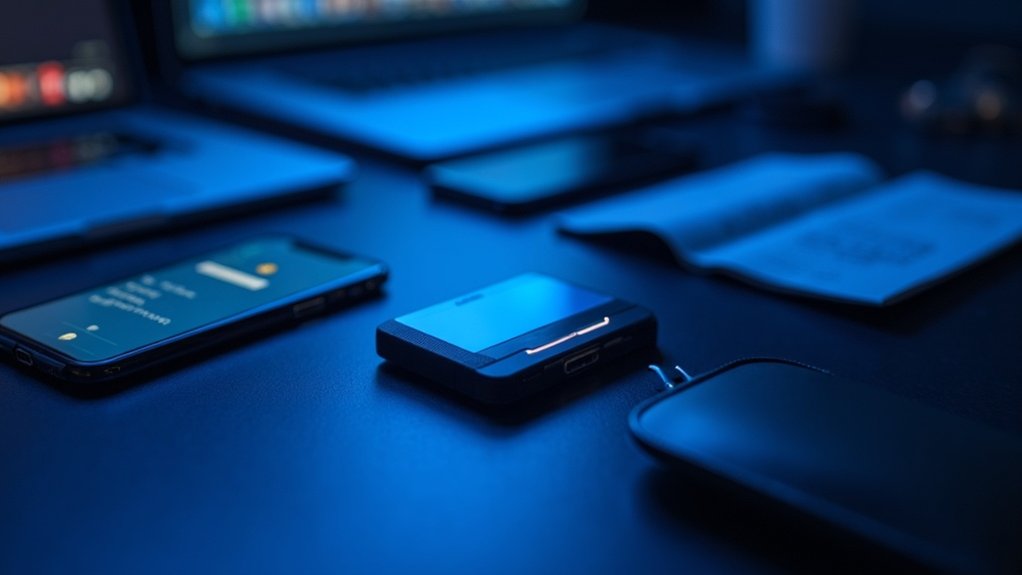Crypto wallets come in five main flavors. Hot wallets stay connected online – convenient but hackable. Cold wallets work offline with specialized chips – old school but super secure. Mobile wallets turn your phone into a crypto terminal – great on-the-go, unless you lose your device. Web wallets trust third parties with your keys – easy but risky. Desktop wallets install directly on computers – a middle-ground option. Each type balances security against accessibility in different ways.
As the crypto market expands like wildfire, the wallet options have multiplied just as fast. Steering through this ecosystem can feel like trying to choose the right tool from an overstuffed garage. Some are built for speed, others for safety.
Hot wallets connect directly to the internet. Convenient? Absolutely. Secure? Not so much. These digital containers support thousands of cryptocurrencies and NFTs while integrating with exchanges for quick trading. Unlike exchanges, they give users full private key control.
Convenience comes at a cost. When your crypto lives online, it’s just one hack away from becoming someone else’s fortune.
MetaMask, Trust Wallet, Coinbase Wallet – they’re everywhere. But their online exposure makes them vulnerable. Hackers love them. No surprise there.
Cold wallets sit at the opposite end. Offline. Secure. Untouchable by random internet predators. Hardware wallets like Ledger Nano and Trezor use specialized chips similar to what’s in your credit cards. Top-tier options like Ledger support over 5,500 assets across various blockchains.
They’re physical devices requiring your actual presence to authorize transactions. Old school, but effective.
Mobile wallets turn smartphones into crypto terminals. They’re perfect for people who need crypto access while grabbing coffee or pretending to listen during boring meetings.
Trust Wallet and BlueWallet fit in your pocket. Convenient? Yes. But lose your phone, and you might lose more than just your contacts.
Web wallets store keys on someone else’s servers. You’re fundamentally trusting a stranger with your digital fortune. Access from any browser sounds great until phishing attacks enter the picture.
They’re training wheels for crypto newcomers.
Desktop wallets install directly on computers, keeping keys on your hard drive instead of floating in the cloud. They’re more secure than web options but tie you to a single device.
Exodus and Sparrow are popular choices for the computer-bound investor. Sparrow is especially noteworthy for being Bitcoin-specific and supporting integration with the Lightning Network for faster transactions.
Paper wallets take things back to basics – literally printing keys on actual paper. They’re immune to hacking unless someone develops malware for eyeballs.
But spill coffee on them? Game over.
Each wallet type represents a compromise between security and convenience. The crypto world hasn’t figured out how to give us both. Not yet, anyway.
Frequently Asked Questions
How Do I Recover My Wallet if I Forget My Password?
Recovery depends on wallet type.
For non-custodial wallets, enter the seed phrase (those 12-24 random words) into the app. No seed phrase? You’re probably screwed.
Custodial wallets might offer password resets through support channels. Some specialized software can attempt to crack passwords if you have the wallet files.
Professional recovery services exist, but watch out—scammers everywhere in crypto.
Bottom line: without that seed phrase, odds aren’t great.
What Fees Are Associated With Different Types of Crypto Wallets?
Different wallets, different fees.
Custodial wallets charge trading fees (0.1-0.6%), deposit fees (sometimes 3.49% for cards), withdrawal fees, and monthly custody charges.
Non-custodial hot wallets? Free software, but you’ll pay network gas fees. Those in-app swaps cost extra too.
Hardware wallets hit you upfront ($50-$400). No maintenance fees though.
Exchange-integrated wallets combine exchange fees with network costs.
Everyone gets you somewhere.
Blockchain ain’t running a charity, folks.
Can Government Agencies Track Transactions Made Through Crypto Wallets?
Yes, government agencies can track most crypto wallet transactions. They’re not blind.
Blockchain is public—every transaction sits there for anyone to see. Exchanges hand over user data when required by law.
KYC requirements? They exist for a reason. Those fancy blockchain analytics tools government agencies use? Pretty effective.
Privacy coins and mixers offer some protection, but agencies are getting better at tracking those too.
Complete anonymity in crypto? That’s mostly a myth these days.
Are Multi-Currency Wallets as Secure as Single-Currency Wallets?
Security comparison between multi-currency and single-currency wallets isn’t black and white.
Multi-currency wallets expose users to more blockchain vulnerabilities but distribute risk across assets. Single-currency wallets limit exposure but concentrate it.
The real difference? Attack surface. Multi-currency wallets are more complex, creating more potential entry points.
But they also offer extensive security features. Trade-offs exist either way. No perfect solution here, folks.
Security ultimately depends on implementation quality and user practices.
How Often Should I Update My Wallet Software?
Users should update wallet software immediately when new versions release. No exceptions.
Hot wallets need more frequent updates since they’re internet-connected and vulnerable to attacks. Cold wallets? Less urgent but still important.
Delay updates and risk theft. Simple as that. Many hacks exploit outdated software – an easily preventable mistake.
Subscribing to official channels helps track release schedules. Government regulations and emerging threats drive update frequency too.
Bottom line: staying current means staying secure.









